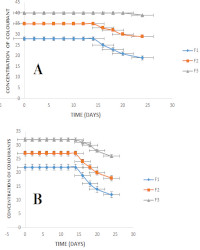Stability Studies of Daucus carota (Apiaceae) Extracts as Colourant in Paracetamol Syrup Formulation
Keywords:
Colourant, Daucus carota, light, paracetamol, temperature.Abstract
Background: Colouring agents are pharmaceutical excipients used in imparting a distinctive appearance on pharmaceutical dosage forms thereby making them appealing, appetizing and distinctive. The stability of colourants is signifificantly affffected by environmental factors such as light, temperature, relative humidity and atmospheric oxygen. The study was carried out to determine the stability of Daucus carota (carrot) extracted pigment which was used as a colourant in paracetamol syrup formulation.
Method: The dried plant material was macerated using ethanol as the extractive solvent. Paracetamol syrup was formulated using formula from the British Pharmacopoeia (BP), and the extracted pigment (20% and 40%) was added as the colourant and stored in both plain and amber coloured bottles and subsequently compared to amaranth, a synthetic colourant which was used as the standard. The effect of light and temperature at 37°Cand 52°Con the colourant was also determined over a period of 14 days.
Results: All coloured formulations used for drug stability studies showed a signifificant decrease in concentration of the colourant over the study period. The result obtained from light stability studies showed better stability when stored in amber bottles than in plain bottles for all colourants however, there was a gradual decrease in the concentration of D. Carota and amaranth with increase in temperature.
Conclusion: The stability and physicochemical properties of Daucus carota extract have shown its potential as a natural colourant in the formulation of liquid pharmaceutical dosage forms.
References
Agronews (2017). Sokoto carrot farmer push for seeds, processing plant, Sokoto. www.Agronews.com, 3rd edition, pp 15-18.
Chengaiah K (2010). Medicinal importance of natural dyes, A review. International Journal of Pharmaceutical Technology and Research, 2(1): 144-154.
Frimpong G (2014). Potential of aqueous extract of Hibiscus sabdariffa calyces as colouring agent in three pediatric oral pharmaceutical formulations. Journal of Applied Pharmaceutical Science, 4(12): 1-7.
Khale H (2014). Colouring Agents: Current Regulatory Perspective for Colouring Agents Intended for Pharmaceutical and Cosmetic Use. International Journal of Pharmaceutical and Phytopharmacological Research, 3(5): 365-373.
Khanal D (2013). Helping Ingredients (excipient) in Pharmaceutical formulation: Colouring Agents – use and health concern. Journal of Manmohan Memorial Institute of Health Sciences, 15 (6): 40-48.
Allam (2011). Colorants the Cosmetics for the Pharmaceutical Dosage Forms. International Journal of Pharmacy and Pharmaceutical Sciences, 3(3): 13-21.
Lakshmi C (2014). Food Colouring: The Natural Way. Research Journal of Chemical Science. 4(2): 87-96.
Pramod KB, Manoj KM, Anupam SB and Vivek KY (2015). An updated review on colourants as pharmaceutical excipients, International Journal of Pharmaceutical, Chemical and Biological Sciences. 5(4): 1004-1017.
Dias J (2014). Nutritional and health benefits of carrots and their seed extracts. Food and Nutrition Science, 5(22): 9-18.
Haq and Prasad K (2015). Nutritional and processing aspects of carrot (Daucus carota) - A review. South Asian Journal of Food Technology and Environment, 1(1): 1 - 14. http://dx.doi.org/10.1080/23311932.2015.1096184.
Mortensen A (2006). Carotenoids and other pigments as natural colourants. Journal of Pure and Applied Chemistry, 78(8): 1477-1491.
Tehniat S (2014). DPPH Free Radical scavenging activity of tomato, cherry tomato and watermelon: Lycopene extraction, purification, and quantification. International Journal of Pharmacy and Pharmaceutical Sciences, 6(2): 223-228.
Geographic Information System (2020). Generated by GIS Laboratory Department of Geography. Faculty of Social Sciences, Usmanu Danfadiyo University Sokoto. P. 53.
American Herbal Products Association (2017). Guidance on Limits of Foreign Matter in Herbal Ingredients; Pp 1-4.
Polydera A, Stoforos N and Taoukis P (2005). Quality degradation kinetics of pasteurised and high pressure processed fresh Navel orange juice: Nutritional parameters and shelf life. Journal of Food Science and Emerging Technology 6(1):1-9. http://dx.doi.org/10.1016/j.ifset.2004.10.004
Vieira M, Teixeira A and Silva C (2000). Mathematical modeling of the thermal degradation kinetics of vitamin C in cupuaçu (Theobroma grandiflorum) nectar. Journal of Food Engineering, 43(1):1-7.
Tol a BY and Rama swamy HS (2015). Temperature and high pressure stability of lycopene and Vitamin C of watermelon juice. African Journal of Food Science, 9(5): 351 - 358. DOI:10.5897/AJFS2014.1258
Vikram V, Ramesh M and Prapulla S (2005). Thermal degradation kinetics of nutrients in orange juice heated by electromagnetic and conventional methods. Journal of Food Engineering, 69(1):31-40. http://dx.doi.org/10.1016/j.jfoodeng.2004.07.013
Xianquan S, Shi J, Kakuda Y and Yueming J (2005). Stability of lycopene during food processing and storage. Journal of Medicine and Food Sciences, 8(4): 413- 422. https://doi.org/10.1089/jmf.2005.8.413
Ahmed J, Shivhare U and Sandhu K (2002). Thermal degradation kinetics of carotenoids and visual colour of papaya. Journal of Food Sciences, 67(7): 2692-2695. http://dx.doi.org/10.1111/j.1365-2621.2002.tb08800.x

Published
How to Cite
Issue
Section
License

This work is licensed under a Creative Commons Attribution-NonCommercial 4.0 International License.

